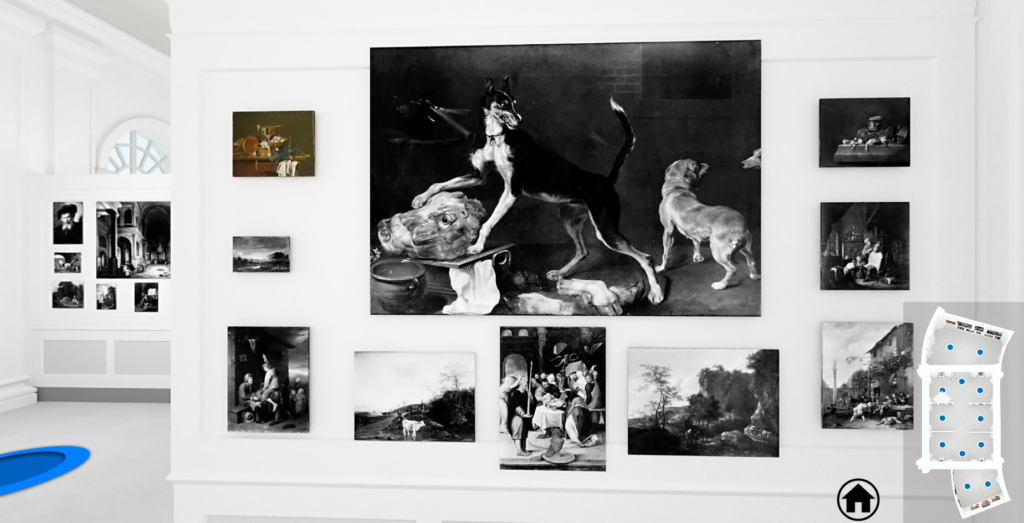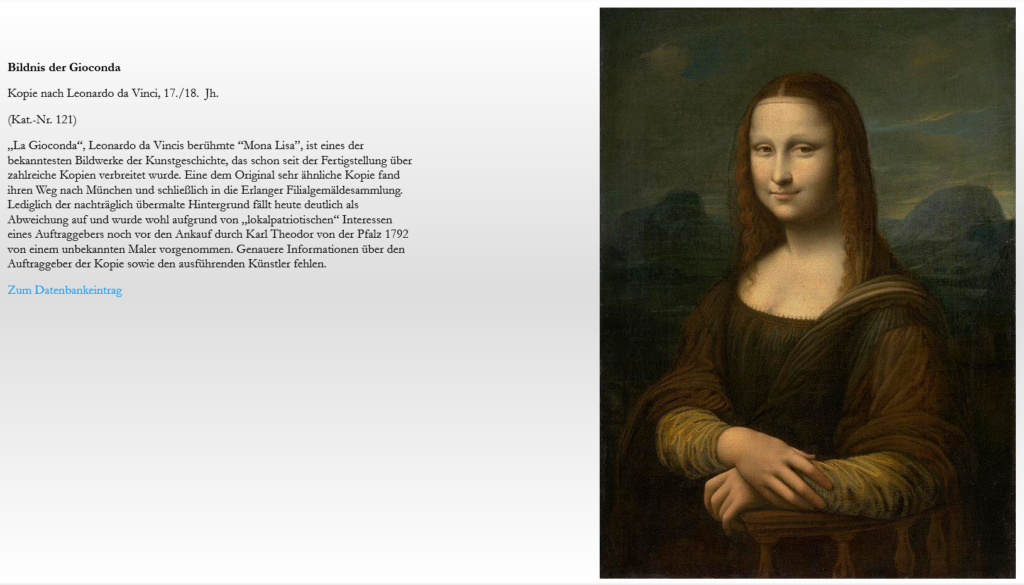Experience art history in 3D
FAU students create a digital reconstruction of Erlangen art gallery
In the “Orangerie digital” project, the Institute of Art History at FAU has digitally recorded the Erlangen art gallery (1906-1934) and reconstructed the exhibition in a 360° tour, with the help of students from the Institute. The project gave the students valuable insights into research and their future career.
Aert van der Neer’s enigmatic “Moonlit landscape” and David Ryckaert’s work depicting “Children playing in an alley” hang below a deceptively real-looking “Still life” by Pieter Horeman, a composition in the shape of a pyramid made of food, kitchen utensils and a plucked partridge. The order for hanging the paintings in the Orangerie chosen in 1906 followed the symmetrical pattern typical in galleries at that time, where paintings were arranged covering whole walls. From 1906 to 1934, the Wassersaal housed works from Dutch artists, the late Renaissance period and the Baroque period, while Italian and German art was displayed in the side wings. The exhibition in the painting gallery, which was primarily used for teaching purposes, was also open to the public as a “Kleine Pinakothek” and included works from the royal Bavarian art collection, including historical copies of famous works such as Leonardo’s Mona Lisa. Students of the Institute of Art History curated the entire collection in an online catalog.
Prof. Dr. Heidrun Stein-Kecks, who is responsible for the project at the Institute of Art History, explains that the idea to digitally reconstruct the exhibition in the Orangerie was first raised in the early 2000’s. Over time, the idea for the project was explored in various seminars and final theses, slowly taking shape until it was finally presented in the Long Night of Sciences in 2019. The IT company “ercas solutions” was fascinated by the project and approached the students, and that was the start of their collaboration.
To the digital 360° tour
Digital skills for digital art
Students were involved in implementing the 3D reconstruction as part of a seminar, providing the IT company with information and images. “The seminar was more like a workshop,” explains student Madlen Gulitsch, who was involved in the “Orangerie digital” project. She and her fellow students wrote texts describing the individual paintings in the virtual tour and the art collection in the online catalog, learning to give a brief and concise summary of the large volumes of information available on each of the works. It wasn’t always easy to keep track of the 169 paintings. The texts were checked using a peer review procedure. While writing the descriptions of the paintings, the students used the software “WissKI” which FAU helped develop (see box). Madlen explains that this gave students an insight into fundamentals of computer science. “We learned how a database works and what users require in order to be able to use it, we learned to differentiate between what is relevant and what is redundant.”
 “We teach students digital skills as they are crucial for art history research and professional practice, and also because art can be produced digitally,” explains Heidrun Stein-Kecks. It is important from the point of view of contemporary art to teach students how art can be made in the virtual space.
“We teach students digital skills as they are crucial for art history research and professional practice, and also because art can be produced digitally,” explains Heidrun Stein-Kecks. It is important from the point of view of contemporary art to teach students how art can be made in the virtual space.
Working on creating a virtual museum during a university seminar is therefore perfect preparation for their future careers. Digital reconstruction is standard in most museums nowadays. It is a way to transfer knowledge about art and cultural objects without subjecting the cultural goods to any addition strain. “It’s a great opportunity,” enthuses Madlen Gulitsch. The “Orangerie digital” project allows viewers to experience the centuries old European art at first hand once more. In future, there at plans to enhance the virtual tour using augmented reality (AR). Visitors could then look at the paintings through AR smart glasses. The Institute and the students are already working on putting their ideas into practice.
Digital network for cultural goods
The abbreviation “WissKI” stands for Wissenschaftliche Kommunikations-Infrastruktur (Academic Communication infrastructure) and refers to a virtual research environment that allows for networking and collaborative academic working. WissKI was developed by the Digital Humanities Group of the Department of Computer Science at FAU in collaboration with the Germanisches Nationalmuseum (GNM) and the Zoologisches Forschungsmuseum Koenig (ZFMK). “Its ability to depict specific and complex connections using semantic web technologies makes the open source software particularly attractive for humanities projects, and therefore also a popular choice for students’ final theses and doctoral theses,” explains Heidrun Stein-Kecks. Indispensable support is also offered by the FAU Competence Unit for Research Data and Information CDI that is responsible for hosting and maintaining the WissKI entities developed at the University, including Orangerie digital.
You can read all about WissKI in this press release on the launch of WissKI.
Further information:
Prof. Dr. Heidrun Stein-Kecks
Senior Professor of History of Arts
Institute of Art History
heidrun.stein-kecks@fau.de
